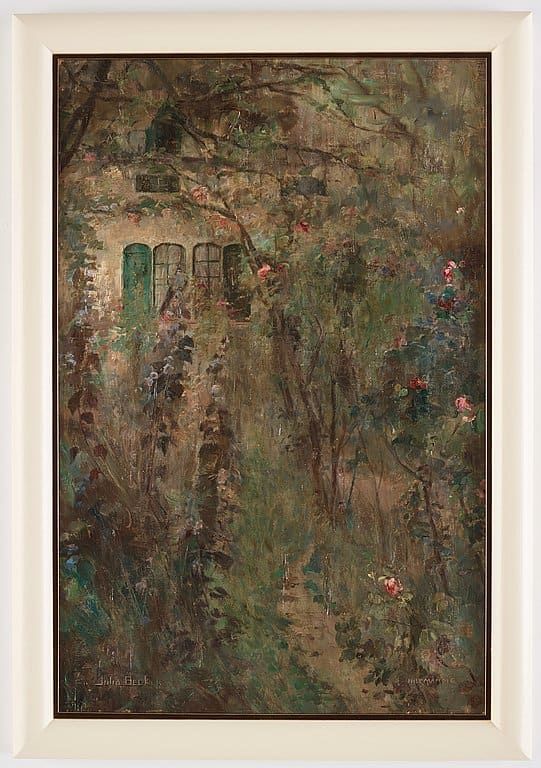Julia Beck
I trädgården, Normandie (In the garden, Normandy)
, 1906Apart from Grez-sur-Loing; Carolles and Le Val St Martin were probably of greatest importance for Julia Beck’s development as a landscape painter. These picturesque settlements on the French Atlantic coast in Normandy inspired Beck to create some of her most outstanding works. It was, initially, the coastal village of Carolles that attracted Beck to Normandy, in the summer of 1884. Kåa Wennberg writes (in Julia Beck, 2012):
It was the small coastal village of Carolles between the towns of Avranches and Granville, which was the real destination of Julia Beck’s journey. The village is located high up, right by the sea, and steep cliffs, falaise, plunge right down to the shallow sandy beach, where the tide makes itself strongly felt. This barren and magnificent environment had, for two years, been home to the Swedish landscape painter Per Ekström. Julia Beck’s arrival in the village coincided with Georg Arsenius’ and Johan Tirén’s stays there, as did the French artist André Godeau. A small artists’ colony was thus formed there in the summer of 1884.
In the summer of 1887, Beck returned to Normandy. This time, however, to Flamanville, a few miles west of Cherbourg, where she painted with Richard Bergh (1858 - 1919). Summer Evening in Flammanville, one of her paintings from this stay, was shown at the World Exhibition in Paris in 1889. Beck’s delight in the coastal landscape is evident from a letter to Nils Kreuger (1858 - 1930) on 2 November 1887: “A delightful summer, which has made me 10 years younger...”. Kåa Wennberg, once again, writes:
She wrote these lines from Val-Saint-Martin, just south of Rouen, where she stayed for a year. The forest and river landscapes of the area inspired her to create a series of beautiful paintings, often with the River Risle as the central motif. Here she gave her paintings a form that showed clear associations with the Japanese art that was in vogue at the time. As with the Japanese style of composition, she often set the horizon high. She also wanted to capture the French haze that made the colors mild.
Even after moving to Vaucresson, in 1888, Beck would visit Normandy regularly. Beginning around 1900, she began to take an interest in other sceneries than the natural untamed landscape. Traces of human presence became more prominent (in the form of cultivated gardens and man-made structures like houses and churches) in paintings like Le Reveil (1909, oil on canvas, 55 x 33 cm, private collection), which depicts the gable of a church ruin during sunrise. Beck’s decision to depict some of these motifs (like Starry night, scene from Normandy, 1911, oil on canvas, 83.5 x 23.5 cm, private collection) in dusk, or when night had already fallen, may be connected to her (potential) interest in the symbolist currents in art, around the turn of the century.
In the garden, Normandy belongs to a transitional phase in Beck’s production. The subject is clearly related to her output post-1900, and the palette appears somewhat muted and subdued, compared to the paintings from the 1880s. The scene, however, is also characterized by a dreamy atmosphere that evokes feelings of slight melancholy in the beholder. Obviously, a result of direct study of nature the picture also communicates Beck’s (supposed) mood when she was depicting the garden. This feeling also characterizes her finest works from 1882 - 1887.
Alexandra Herlitz touches upon this in: Grez-sur-Loing revisited. The international artist’s colony in a different light(Academic dissertation for the Doctor of Philosophy degree in Art history, University of Gothenburg, 2013): “Hers are sentimental landscapes in which the melancholic mood is the most striking element. With her tonal approach and mild greyish palette she is aligned with the colony’s [Grez-sur-Loing] prevailing expression in the early 1880s, even without the employment of figures”.
Provenance
Private collection, Sweden (acquired in Gothenburg, Sweden in the 1930s).
By descent.
Bukowskis, Stockholm, Important Winter Sale, 7 December 2023, lot 599.
Firestorm (acquired at the above sale).
Copyright Firestorm Foundation
